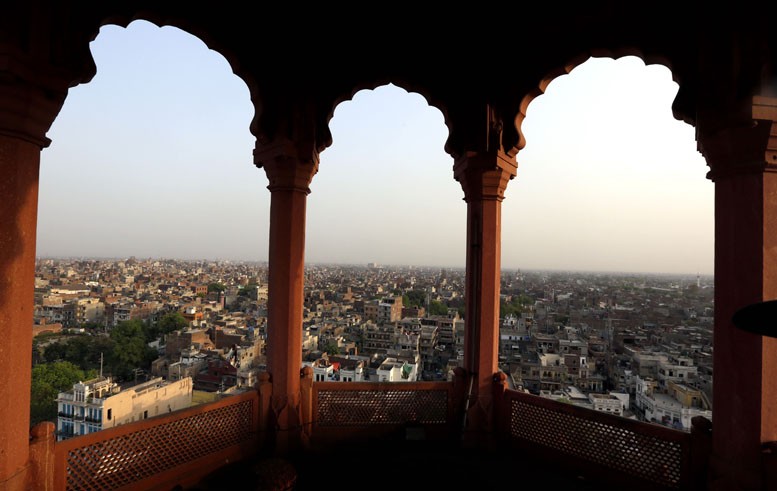

Where urbanisation is a natural phenomenon, counter-urbanisation becomes a necessity. Lahore has been the hub of trade and the centre of knowledge, but the city is now turning into a jungle full of people from everywhere around, which has not only begun to affect the social and civic life of its dwellers but also their health and education.
The city is expanding at a fast pace, not because of high birthrate as much as due to an unchecked and unrestrained inflow of people from rural areas. The ‘City of Gardens,’ which it was once called, is turning into a congested place.
However, Lahore is not an exception -- other cities of Pakistan, including Karachi, Hyderabad, Faisalabad, Rawalpindi and Peshawar, are also hit by a growing urbanisation. The cash-starved provincial governments are unable to allocate enough funds to provide healthcare and educational facilities for this growing mass of ‘immigrants,’ so to say. Another natural result of the phenomenon is a lack of qualified and skilled workforce.
According to the United Nations Habitat programme, Pakistan’s urban population is set to increase by 50 percent in the next decade and half. After assuming office, Prime Minister Imran Khan called for a moratorium on the development of new housing colonies in the private sector, and advocated building high-rises so as to stop the horizontal expansion of cities and, thus, save the agriculture land. Little has been done to that effect.
Overpopulation not only affects the quality of life of the people in general but also gives rise to a variety of day-to-day issues -- the traffic snarl-ups every time you step out of your house, the shopping malls with no space for parking, and the lack of capacity-building of government officials, and so on.
The 18th constitutional amendment is a positive step towards empowering the provinces, but the officials of the provincial governments need to adopt fresh methods to improve governance and implement the required civic laws. The frequent change of governments also mars the efforts to adopt a consistent urban policy. As a developing nation, the official hierarchy has to be proactive to understand and execute plans funded by the local government and international organisations to improve the civic life.
The last water supply scheme in Lahore was implemented 40 years ago, that too with the help of a foreign donor agency whereas the population of the city multiplied many times since. Unfortunately, we have a history of negligence and administrative failure, and despite the establishment of local government institutions and administrative changes, not a single positive change was brought to the city of Lahore to improve the quality of life of the common man. The environmental disregard is witnessed as the factories are allowed to function in residential areas where other than noise pollution tires are used as fuel, which causes numerous health issues for the people living in surrounding areas.
On the official level, the Ministry of Climate Change is closely working with the UN-Habitat in Pakistan on various initiatives to understand the vulnerabilities of climate change in line with the United Nations’ Sustainable Development Goals (SDGs).
The prime minister talks about the vertical expansion of cities by constructing high-rise buildings, but this could take years to be implemented. No official committee or an institution has been set up to look after the issue and work out modalities. Faisalabad is Pakistan’s third largest city but lacks education and health facilities which transfers additional burden to Lahore.
The concept of high-rise buildings is not without its problems, and Karachi is the classic example of it. Gulistan-e-Jauhar, which is spread over hundreds of acres is called the "graveyard of flats," and it seriously affects not only the civic life but also the security situation. Dozens of people living in a single building have their set of issues apart from the often choked sewerage lines and water supply.
Ahmad Rafay Alam, an environmental lawyer, tells TNS that the government has at last realised the perils of the horizontal expansion of cities and consumption of agricultural land in housing projects, but still we have miles to go to implement an urban goals agenda and devise plans to provide the amenities of life to the city dwellers.
According to him, steps are required to facilitate and encourage the private entrepreneurs to participate in the construction sector. Lahore is the centre of attraction even for the people in nearby cities like Gujranwala, and they move to Lahore for education and employment purposes.
Jameel Mughul, a real estate developer, is of the view that the government needs clarity in laws in order to bring transparency in transfer of property from sellers to buyers. "If a housing society is planned without ‘planning,’ the official rigmarole is there to discourage the fair property deals."
An official of the Lahore Development Authority (LDA) says on condition of anonymity that the overhauling of all the departments in the city government, including the Lahore Metropolitan Corporation (LMC) is the need of the hour. He insists that the government departments related to housing sector are mired in corruption and mismanagement.
The official also speaks of not having received any summary from the government regarding work on the vertical planning of the cities.
The fact remains that counter-urbanisation is indispensable to maintain the quality of life and social order in the cities. Otherwise, residential areas like katchi abadis in Lahore will become symbols of ‘urbanisation.’